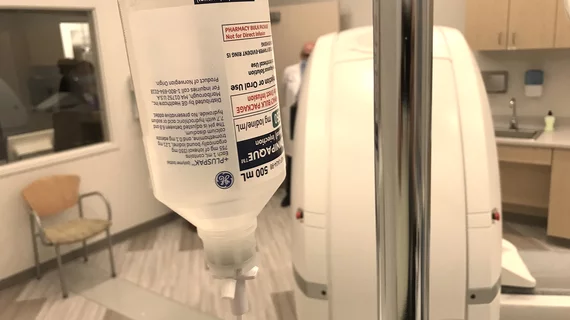Using high concentration contrast media reduces patients' pain and discomfort during injections
Opting for high concentration contrast media during CT scans of patients with difficult veins or poor venous conditions can improve comfort without compromising image quality.
While most safety considerations associated with contrast injections, like hypersensitivity reactions and extravasation, rarely become reality, pain at the injection site is much more common. This is especially true for patients with poor venous conditions, who are also at greater risk of adverse events related to CM administration, authors of a new study in the European Journal of Radiology recently explained.
“Since iodinated contrast media are intravenously injected at high pressure, the venous conditions are critical for patient’s pain sensation and comfort,” corresponding author Miao-Ning You, from the Department of Breast Oncology at Peking University Cancer Hospital and Institute in China, and colleagues noted. “In clinical practice, the venous conditions can be graded as level 0 to 3 according to patient’s age, venous filling, visibility, palpability, and circulation status.”
Levels 0-1 represent the most ideal venous conditions, whereas veins graded between 2-3 are at higher risk of adverse events and more prone to pain.
To better understand how swapping from low to high concentration contrast affects patient comfort, experts recruited 206 patients with poor venous conditions who were set to undergo a contrast enhanced CT scan of the abdomen. One group of 99 patients received high concentration contrast (iomeprol 400), while another group of 107 were given a lower concentration CM (ioversol 320), both at an identical iodine delivery rate of 1.12 gI/s.
Patients rated their pain on a scale of 0-10, with higher scores indicating higher pain and discomfort.
The high concentration group’s scores ranged from 0 to 2, while the low concentration group’s ratings sat between 2 and 4. High concentration CM improved discomfort scores, too, with ratings ranging from 0 to 3 in the high group and 2 to 5 in the low group.
Encouragingly, instances of extravasation and hypersensitivity reactions did not differ significantly between the groups. Image quality remained consistent as well, with the high concentration group actually garnering higher clarity scores for visualization of the intrahepatic hepatic artery and portal vein.
The team suggested that their findings provide evidence that high concentration iodinated CM injected at a lower flow rate may be a “preferable choice” for patients with poor venous conditions.
Learn more about the research here.

